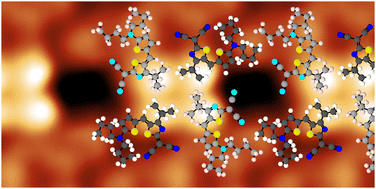Chiral self-organized single 2D-layers of tetramers from a functional donor–acceptor molecule by the surface template effect†
Abstract
The ability to control the structural properties of molecular layers is a key for the design and preparation of organic electronic devices. While microscopic growth studies of planar, rigid and symmetric π-conjugated molecules have been performed to a larger extent, this is less the case for elongated donor–acceptor molecules with flexible functional groups, which are particularly interesting due to their high dipole moments. Prototypical molecules of this type are merocyanines (MCs), which have been widely studied for the use as efficient absorbers in organic photodetectors. For maximized light absorption and optimized electronic properties the molecular arrangement which is affected by the initial assembly of the films at the supporting substrate interface is decisive. The situation deserves special attention, when the surface nucleation leads to so far not known and bulk-unlike aggregates. Here, we report on the growth of a typical MC (HB238) on the Ag(100) surface, serving as the substrate. In the energetically preferred phase, the molecules adsorb in a face-on geometry and organize in tetramers with a circular dipole arrangement. The tetramers further self-order in large, enantiopure domains with a periodicity that is commensurate to the Ag(100) surface, likely due to a specific bonding of the thiophene and thiazol rings to the Ag surface. Using scanning tunneling microscopy (STM) in combination with low energy electron diffraction we derive the detailed structure of the tetramers. The center of the tetramer, which is most prominent in STM images, consists of four upward pointing tert-butyl groups from four molecules. It is encircled by a ring of four hydrogen bonds between terminal CN-groups and thiophene rings on neighboring molecules. In parallel, the surface interaction modifies the intramolecular dipole, which is revealed from photoemission spectroscopy. Hence, this example shows how the surface template effect leads to an unforeseen molecular organization which is considerably more complex compared to that in the bulk phases of HB238, which feature paired dipoles.



 Please wait while we load your content...
Please wait while we load your content...